Teodorescu P.P. Mechanical Systems, Volume III: Analytical Mechanics
Подождите немного. Документ загружается.

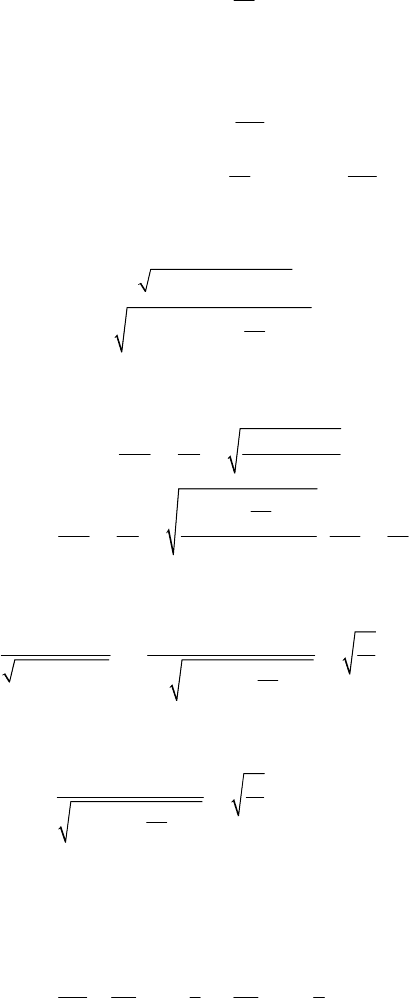
Hamiltonian Mechanics
201
If
=+
2
1
(,) () ()
r
Ur U r U
r
θ
θθ,
(19.2.90)
then Hamilton’s function is of the form (19.2.46), with
==−=
== =− + ==
2
1
2
2
2
(, ) () ,
2
(;, ) () .
2
r
rr r r
p
ggp U a
m
g
p
Hg ggrp Ur a h
m
r
θ
θθ θ θ
θ
θ
θθ
One obtains the generalized momenta
[]
=+
⎡
⎤
=++
⎢
⎥
⎣
⎦
1
1
2
2(),
2() .
rr
pmUa
a
pmUr h
r
θθ
θ
(19.2.90')
Taking into account the partial derivatives
()
(
)
∂+
==
∂
−+
∂
∂
== =
∂∂
1
1
2
1
2
1
2
,
2
1
,,
r
rr
r
gp Ua
pm m
a
Uh
g
gp
r
pm m a
r
θθ θ
θ
the formulae (19.2.47') give the trajectory of the particle
P in the form
−=
+
−+
∫∫
1
1
2
1
2
dd2
()
()
r
r
b
a
m
Ua
rUr h
r
θ
θ
θ
,
(19.2.90'')
and the formula (19.2.47'') specifies the motion on this trajectory by the equation
()
=+
−+
∫
2
1
2
d2
()
r
r
tb
a
m
Ur h
r
.
(19.2.90''')
The problem is thus reduced to quadratures.
If
=>/, 0Ukrk (case of forces of Newtonian attraction), then the
Hamilton-Jacobi equation is written in the form
()
()
()
∂∂
⎡⎤
++ −=
⎢⎥
∂∂
⎣⎦
22
2
11
0
2
SSk
S
mr r rθ
.
(19.2.91)
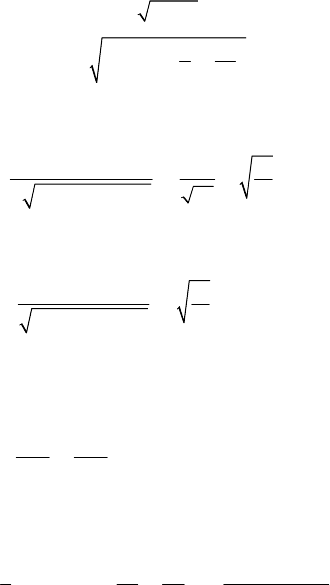
MECHANICAL SYSTEMS, CLASSICAL MODELS
202
As a matter of fact, this case is contained in the previously considered one. The
generalized momenta are (
== >0, / , 0
r
UUkrk
θ
, and θ is a cyclic co-ordinate)
()
=
=+−
1
1
2
2,
2.
r
pma
a
k
pmh
r
r
θ
(19.2.91')
The trajectory of the particle is given by
=−
+−
∫
1
2
1
1
d2r
b
am
rhr kr a
θ
,
(19.2.91'')
the motion on the trajectory being specified by
()
=+
+−
∫
2
2
1
d2rr
tb
m
hr kr a
.
(19.2.91''')
Let us suppose that the particle
P lies on a surface S for which the element of arc
is given by a relation of the form
()
⎛⎞
=+ + = = =
⎜⎟
⎝⎠
22
12
2
12
12
dd
d,(),(),1,2
jjjjjj
qq
sQQ PPqQQqj
PP
.
(19.2.92)
In this case, one obtains the kinetic energy
()
()
+
⎛⎞
=+ +=
⎜⎟
+
⎝⎠
22 2 2
12 1122
12
12 12
1
22
qq PpPp
TQQ
PP QQ
.
(19.2.92')
If the particle is subjected to no one given force (
= 0U ), then it results =HT and
we can apply Liouville’s theorem. By separation of variables, hence by quadratures,
one can obtain thus the possible trajectories (depending on the integration constants); in
fact, thus are specified the geodesic lines of the surface. The surfaces which have this
property are called Liouville’s surfaces.
19.2.3.3 Problem of Two Particles. Motion of Planets
The problem of two particles has been considered in Sects. 19.3.2.3 and 18.1.3.2,
assuming the action of forces of Hamiltonian attraction. The generalized system has
three degrees of freedom and we can choose the generalized co-ordinates
===
123
,,qrq qθϕ; assuming that we study the relative motion of a particle with
respect to the other one, we take the latter one as origin of the frame of reference. We
can thus use the results obtained in Sect. 19.2.3.1 for the motion of a free particle (in
spherical co-ordinates – the formulae (19.2.75'), (19.2.75''), and (19.2.75''')).
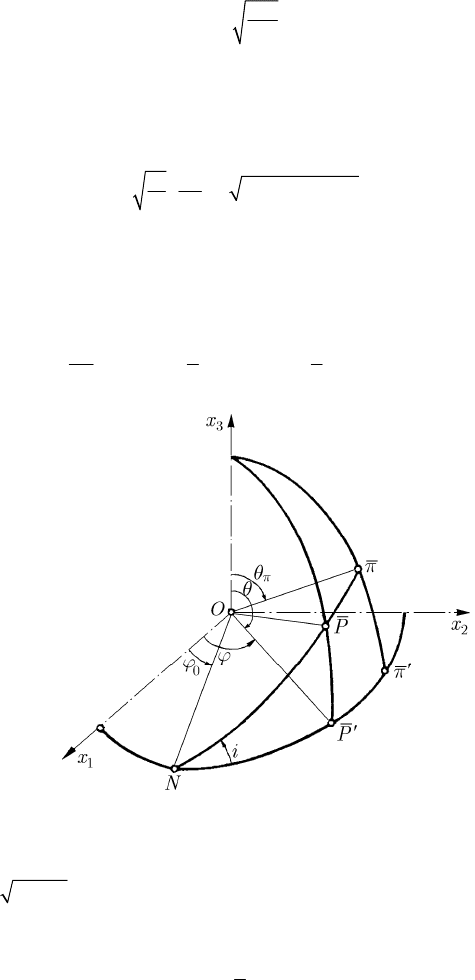
Hamiltonian Mechanics
203
We assume that the initial position of the particle in on the line of nodes
ON , in the
plane
12
Ox x (Fig. 19.1); hence, for =
0
tt we have == =
00
/2,θθ π ϕϕ. Imposing
these conditions, it results
=− =
00
31
1
,
2
m
btb
a
ϕ .
(19.2.93)
As far as we know, the trajectory of the particle is an ellipse of semi-major axis
a and
eccentricity
e ; in this case, =−
min
(1 )rae and =+
max
(1 )rae. By differentiation of
the equation (19.2.75'''), we obtain
=+−
2
2
d
2d
mr
rhrkra
t
.
The extreme values of the vector radius
r must annul the quantity under the radical.
From Viète’s relations, it results
+==−
max
min
2/rr akh, =−
22
max
min
(1 )rr a e
=−
2
/ah , wherefrom
()
−
=< = −=>
2
2
0, 1 0
22 2
kk k
haaep
a
.
(19.2.93')
Fig. 19.1 Motion of the Sun and of a planet
We notice that for a given colatitude
θ one must have −≥
2
21
/sin 0aa θ , hence
≥
12
arcsin /aaθ ; but
min
θ is just the complement of the angle i made by the plane
of the orbit with the plane
12
Ox x . Hence,
==
22
12
cos cos
2
k
aa i p i.
(19.2.93'')

MECHANICAL SYSTEMS, CLASSICAL MODELS
204
The trajectory will be given by (for
θ we take the inferior limit /2π , corresponding to
a point on the line of nodes, while for
r we take the inferior limit =−
min
(1 )rae,
corresponding to the pericentre
π )
[][]
−
=−
−
−
−=
+− − −
∫
∫
∫
0
22
/2
22
/2
2
(1 )
cos d
,
sin sin cos
sin d
1
sin sin cos
d
,
(1 ) (1 )
r
ae
i
i
p
i
k
ab
m
ae ae
θ
π
θ
π
ϑ
ϕϕ
ϑϑ
ϑϑ
ϑϑ
ρ
ρρρ
(19.2.94)
while the motion on the trajectory will be specified by
[][]
()
−
=−
+− − −
∫
0
(1 )
d
,
(1 ) (1 )
r
ae
k
att
m
ae ae
ρρ
ρρ
(19.2.94')
At the moment in which the particle attains the pericentre
π , the second equation
(19.2.94) becomes
==−
−−
∫∫
22 22
/2 /2
sin d sin d
sin cos sin cosii
ππ
θθ
π
ππ
ϑϑ ϑϑ
χ
ϑϑ
.
with
=−
2
/pkmb
π
χ
. By integrating, we get
=
cos
arcsin
sini
π
π
θ
χ
,
(19.2.93''')
wherefrom
=cos sin sini
π
π
χ
θ
.
(19.2.93
IV
)
Considering the relations between the elements of the spherical triangle
′
Nππ
on a
sphere with the centre
O and of unit radius (the point π is the piercing point of the
radius with this sphere), we see that
p
= N
π
χ
π
. These results correspond to those
obtained in Sect. 9.2.2.4 in the study of the orbit of a satellite. As a matter of fact, we
can imagine that at the pole
O is situated the Sun, the particle P being a planet; in this
case, the plane
12
Ox x is the plane of the ecliptic, while the point π is the perihelion.
Thus, all six parameters (
00
,,, ,aei tϕ and
π
χ
) which define the orbit of the planet are
determined.
We notice that

Hamiltonian Mechanics
205
[][]
(
)
−−
−
=
+− − −
−+ −
−+
−−
===−−
−
−
=− −
∫∫
2
(1 ) (1 )
(1 )
dd
(1 ) (1 )
2
2
arcsin arcsin arcsin
2
4( )
arcsin ,
2
rr
ae ae
r
ae
ap ap
ae ae
aap
ap a
rp rp
er er
aa p
pr
er
ρρ
ρρρ
ρρ ρ
ρ
π
ρ
π
as well as
==−
−
∫
22
/2
sin d
cos
arcsin
sin
sin cos
i
i
θ
π
ϑϑ
θ
χ
ϑ
where the arc
p
= NPχ corresponds to an arbitrary position on the orbit (the point P is
the intersection of the radius
OP with the sphere of unit radius); hence,
(
)
−
−=−−arcsin
2
pr
er
π
π
χ
χ
,
so that
()
(
)
−−
−= − =cos cos arcsin
2
pr pr
er er
π
π
χ
χ
.
Finally, we find the known equation of the trajectory in its plane
()
=
+−1cos
p
r
e
π
χ
χ
,
(19.2.95)
corresponding to the equation (9.2.6). Starting from the equation (19.2.94') and using
the constant
h given by (19.2.93'), we find again the integral given in Sect. 9.2.1.3,
which leads to Kepler’s equation (9.2.13). The first equation (19.2.94) specifies the
motion in the plane of the ecliptic.
Knowing that the trajectory is a plane curve, the problem can be treated in another
way too, choosing the plane of the trajectory as plane
12
Ox x . Considering, further, the
relative motion of a planet with respect to the Sun, we can use polar co-ordinates as in
Sect. 19.2.3.2 (the mechanical system formed by the two particles has two degrees of
freedom in the plane of the motion); the Hamilton-Jacobi equation (19.2.91) leads thus
to the classical equation of the trajectory.
But we can make also a study in orthogonal Cartesian co-ordinates, after Jacobi. The
reduced Hamilton–Jacobi equation will be
()
∂∂
⎛⎞⎛⎞
+=+
⎜⎟⎜⎟
∂∂
⎝⎠⎝⎠
22
12
2
SS k
mh
xx r
.
(19.2.96)
,

MECHANICAL SYSTEMS, CLASSICAL MODELS
206
Taking an arbitrary point
0
P on the
1
Ox -axis, so that =
00
OP r , and denoting
=
0
PP ρ , we have
()
=+ = −+
2
22 2
0
12 1 2
,rxx xr xρ .
(19.2.97)
We will show that the function
′
=+
+
∫
0
d
2
kh
Ss
sr
σ
σ
,
(19.2.96')
where
′
=− =+,rrσρσρ
(19.2.97')
is a complete integral of the equation (19.2.96),
0
r being an essential constant. Indeed,
observing that
σ and
′
σ
depend on
1
x and
2
x by means of r and ρ , it results
−−
∂
⎛⎞ ⎛ ⎞
⎛⎞ ⎛⎞
=+ +−− +
⎜⎟ ⎜⎟
⎜⎟ ⎜ ⎟
′
∂+ +
⎝⎠ ⎝⎠
⎝⎠ ⎝ ⎠
∂
⎛⎞ ⎛ ⎞
⎛⎞ ⎛⎞
=+ +−− +
⎜⎟ ⎜⎟
⎜⎟ ⎜ ⎟
′
∂+ +
⎝⎠ ⎝⎠
⎝⎠ ⎝ ⎠
00
00
11 11
1
22 22
2
,
22
,
22
xxr xxr
Skh kh
mm
xr r r r
xx xx
Skh kh
mm
xr r r r
ρσ ρσ
ρσ ρσ
wherefrom, using the notation (19.2.97), we find (the terms which contain the product
of the two radicals disappear)
−+
∂∂
⎡⎤
⎛⎞⎛⎞
⎛⎞
+=+ +
⎜⎟
⎜⎟⎜⎟
⎢⎥
∂∂ +
⎝⎠
⎝⎠⎝⎠
⎣⎦
−+
⎡⎤
⎛⎞
+− +
⎜⎟
⎢⎥
′
+
⎝⎠
⎣⎦
22
2
0
11 2
0
12
2
0
11 2
0
2( )2
2
2
2( )2
2.
2
xx r x
SS kh
m
xx r r
xx r x
kh
m
rr
ρσ
ρσ
Taking into account the identities
−+
++− −
+==
′
−+
−−+ −
−= =
2
222 22
0
11 2
00
2
222 22
0
11 2
00
2( )2
2
2,
2( )2
2
2,
xx r x
rr r r
rrr
xx r x
rr r r
rrr
ρρ σ
ρρρ
ρρ σ
ρρρ
one sees that the equation (19.2.96) is verified.
The equation of the trajectory and the motion on it will be given by
∂∂= = ∂∂=−
00
/,const,/Sr KK Shtt. We notice that
′
−−
∂∂
∂∂
==− =−=−
∂∂ ∂ ∂
00
11
00 0 0
,
xr xr
rr r r
ρρ
σσ
ρρ
,
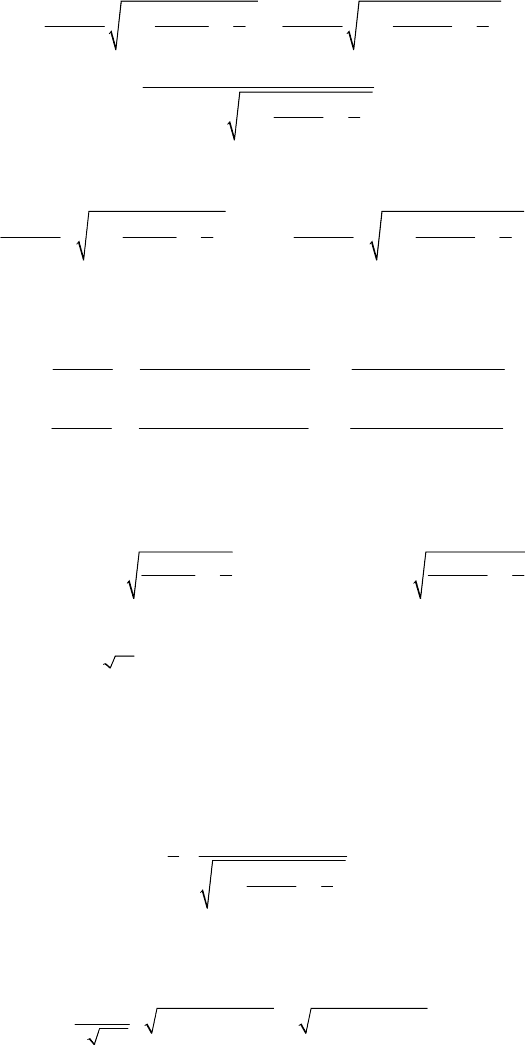
Hamiltonian Mechanics
207
so that the first equation leads to
()
′
−−
⎛⎞ ⎛ ⎞
−+− +
⎜⎟ ⎜ ⎟
′
++
⎝⎠ ⎝ ⎠
−=
⎛⎞
++
⎜⎟
+
⎝⎠
∫
00
11
00
0
0
22
d
.
2
2
xr xr
kh k h
mm
rr
mk s
K
kh
sr m
sr
σ
σ
ρσ ρσ
Effecting the quadrature, we can also write
−−
⎛⎞ ⎛ ⎞⎛⎞ ⎛⎞
−+−+ +=
⎜⎟ ⎜⎟
⎜⎟ ⎜ ⎟
′
++
⎝⎠ ⎝⎠
⎝⎠ ⎝ ⎠
00
11
00
11
22
xr xr
kh kh
mmK
rr
ρσ ρσ
.
Because
−=−−
222
00 0
1
2( )rx r r r ρ , it results
()
()
()
()
′
−
−++ + −
−= =−
′
−
+−− − +
+= =−
222
0
100 00
00
222
0
100 00
00
2
1,
22
2
1,
22
xr
rrr r r
rr
xr
rrr r r
rr
ρρσσ
ρρ ρ
ρρσσ
ρρ ρ
obtaining thus the equation of the trajectory in bipolar co-ordinates (of poles
O and
0
P ) in the form
()
()
()
()
00 00
00
,
22
kh k h
rr rr K
rr
σσ σσ
σσ
′′′
+− ++−+ +=
′
++
(19.2.98)
where
′
=
0
2/KrKmρ is a new integration constant. We have
= 0ρ
, =
0
rr for
the point
0
P
, hence
′
==
0
rσσ ; taking into account the form of the constant
′
K
, we
see that the trajectory, which is a conic, passes through the point
0
P
. The genus of the
conic depends on the sign of the constant
h
; in case of the Solar system we have
< 0h
, the conic being an ellipse.
The motion on the orbit will be specified by
′
−=
⎛⎞
+
⎜⎟
+
⎝⎠
∫
0
0
1d
4
2
s
tt
kh
m
sr
σ
σ
,
(19.2.98')
beginning from the point
0
P for which =
0
tt. If the orbit is parabolic ( = 0h ), then
the integration is immediate, obtaining Euler’s formula
()()
⎡⎤
−= ++ − −+
⎣⎦
33
000
1
6
tt r r r r
mk
ρρ.
(19.2.98'')

MECHANICAL SYSTEMS, CLASSICAL MODELS
208
In the case in which
≠ 0h (elliptic or hyperbolic orbits), analogous formulae have
been given by Gauss.
19.2.3.4 Problem of the Two Centres
We take again the problem of two centres, considered in Sect. 18.3.2.4. The kinetic
energy is given by (18.3.55) and the simple potential reads (18.3.55'), obtaining
Hamilton’s function
()
()()
[]
⎛⎞
=− +
⎜⎟
−−
⎝⎠
−+−−
−
2
2
22
22 2 2
12 12
22
2
1
,
m
H
cc
kk kk
μ
λ
λμ
λμ
λμ
λμ
(19.2.99)
where
λ and μ are elliptic co-ordinates in the plane; m is the mass of the particle,
1
k
and
2
k
characterize the centres of attraction (in inverse proportion to the squares of the
distances), the distance between these centres being
2c
. We find the generalized
momenta
() ()
−−
==
−−
22 22
12
22 2 2
,pm pm
cc
λμλ λμμ
λμ
,
(19.2.100)
so that Hamilton’s function becomes
()()()
()()
[]
=− −+−
⎡
⎤
⎣
⎦
−+−−
−
22 222 222
12
12 12
22
1
2
1
.
Hm cpc p
kk kk
λμ λ μ
λμ
λμ
(19.2.99')
This Hamiltonian is of the form (19.2.51), hence of Liouville’s type, and one can make
the separation of the variables. Thus, we obtain – obviously – the same relations
(18.3.56), (18.3.56'), the trajectory and the motion on the trajectory being obtained by
quadratures (elliptic integrals). The relations (19.2.100) complete then the solution in
the phase space.
This problem has been considered for the first time by Euler (in the plane case); it
has been taken again in a three-dimensional treatment by Lagrange and then by Jacobi,
who integrated it by his general method of calculation. This research has been an
important impetus to enlarge the theory of elliptic integrals. We mention also the results
obtained by Serret, Desboves and Andrade in this direction.
G. Dincă studied, in 1965, the general motion of a particle subjected to the action of
n central forces (which pass through n fixed centres), in a resistant medium; the
problem is reduced to the above considerations, in some interesting particular cases.
These results can be seen also as a first step in the study of the problem of three
particles, which can be solved – in general – only by approximate methods of
calculation; besides, the results can be used in the general problem of
n particles too.

Hamiltonian Mechanics
209
19.2.3.5 Motion of the Rigid Solid
The Hamilton–Jacobi method can be applied, as well, in the case of the free or the
constrained rigid solid
S . As in Sect. 19.1.3.5, we will consider a heavy,
homogeneous rigid solid of rotation, of mass
M , which slides frictionless on a fixed
horizontal plane, having five degrees of freedom. Starting from Hamilton’s function
(19.1.96), one obtains the canonical equations (19.1.96'). The generalized co-ordinates
are
′′
12
,ρρ (which specify the position of the mass centre) and Euler’s angles ,ψθ and
ϕ ; the generalized momenta
12
,, ,ppp p
ψθ
and p
ϕ
are corresponding to them,
3
I and
J are the moments of inertia with respect to the axis of rotation and to an axis normal
to this one (with respect to the movable frame of reference
R ), respectively, while the
function
()f θ specifies the applicate of the mass centre with respect to the fixed plane.
The Hamilton–Jacobi equation reads
()
⎧⎡ ⎤
∂∂ ∂ ∂
⎛⎞⎛⎞
⎛⎞
+++ +
⎨
⎜⎟
⎜⎟⎜⎟
⎢⎥
′′
∂∂ ∂ ∂
′
+
⎝⎠
⎝⎠⎝⎠
⎩⎣ ⎦
⎫
∂∂
⎛⎞
+−+=
⎬
⎜⎟
∂∂
⎝⎠
⎭
22
2
2
2
12 3
2
2
11 1 1
2
()
1
cos ( ) 0 .
sin
SS S S
S
MI
Mf J
SS
Mgf
J
ρρ θ ϕ
θ
θθ
ψϕ
θ
(19.2.101)
Because the constraints are scleronomic and the generalized co-ordinates
′′
12
,,ρρψ and
ϕ are cyclic, we can choose a complete integral of the form
′′
=− + + + + +
11 22 3 4
()Shta a a a Fρρψϕθ,
where
123
,,,ha a a and
4
a are integration constants. Replacing in the equation
(19.2.101), we get the equation
()
()
()
∂
⎡
−+ + +
⎢
∂
′
+
⎣
⎤
++ − + =
⎥
⎦
2
22
12
2
2
2
434
2
3
11 1
2
()
11
cos ( ) 0 ,
sin
F
haa
M
Mf J
aaaMgf
I
J
θ
θ
θθ
θ
which determines the function
()F θ ; we obtain thus the complete integral
′′ ′
=− + + + + + +
∫
2
11 22 3 4
() ()dShta a a a Mf Jρρψϕ θ Θθθ,
(19.2.102)
where we have denoted
[]
()
+−
=− − −−
2
222
124 34
2
3
cos
() 2 ()
sin
aaa aa
hMhf
MI
J
θ
Θθ θ
θ
,
(19.2.102')
the five constants being essential constants.
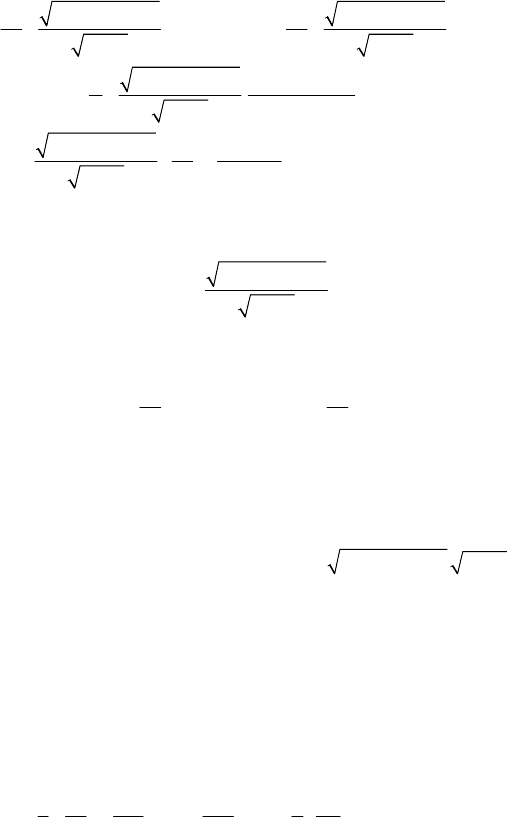
MECHANICAL SYSTEMS, CLASSICAL MODELS
210
Differentiating the function
S with respect to the initial constants, we find the
equations of the trajectory of the representative point
∈
5
P Λ in the form
()
′′
++
′′
−=−=
′
+
−
−=
′
+
⎡⎤
−−−=
⎢⎥
⎣⎦
∫∫
∫
∫
22
12
1122
2
34
3
2
2
4
34 4
2
3
() ()
d, d,
() ()
()
cos
1
d,
sin
()
()
cos
cos d ,
sin
()
Mf J Mf J
aa
bb
MM
Mf J
aa
b
J
Mf J
a
aa b
I
J
θθ
ρθρθ
Θθ Θθ
θ
θ
ψθ
θ
Θθ
θ
θ
ϕθθ
θ
Θθ
(19.2.103)
the motion along this trajectory being specified by the equation
′
+
−=
∫
2
0
()
d
()
Mf J
tt
θ
θ
Θθ
.
(19.2.103')
Replacing the integral (19.2.103') in the first two equations (19.2.103), we obtain
() ()
′′
−= − −= −
12
00
12
,
aa
btt btt
MM
ρρ
;
(19.2.103'')
we find thus again a known result, in accordance to which the projection of the mass
centre on the fixed plane has a rectilinear and uniform motion. The components of the
generalized momentum will be
′
== = == +
2
1122 3 4
, , , , () ()papap ap ap Mf J
ϕ
ψθ
θΘθ.
(19.2.103''')
Let be also the problem of the plane motion of a rigid straight bar, of mass
M ,
attracted by elastic forces (of elastic constant
k ) by the
1
Ox -axis, considered in Sects.
18.3.2.7 and in 19.1.3.5. Hamilton’s function is given by (19.1.97), where
′
1
ρ and
′
2
ρ
(the co-ordinates of the mass centre) and the angle of rotation
θ are the generalized
co-ordinates, while
I is the central moment of inertia with respect to an axis normal to
the plane of motion (see Fig. 18.12 too). The Hamilton-Jacobi equation will be
()
()
22
2
22
2
12
11 1
sin 0.
2
SS S
SkMI
MI
ρθ
ρρ θ
⎧
⎡⎤
∂∂ ∂
⎫
⎛⎞⎛⎞
′
+++++=
⎨⎬
⎜⎟⎜⎟
⎢⎥
′′
∂∂ ∂
⎝⎠⎝⎠
⎭
⎩
⎣⎦
(19.2.104)
The constraints are scleronomic and
′
1
ρ is a cyclic co-ordinate, so that the complete
integral is of the form
′′
=− + + +
11 1 2 2
() ()Shta S Sρρ θ.
